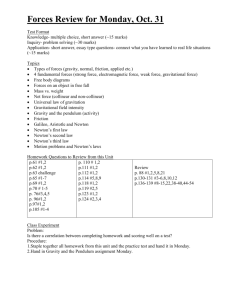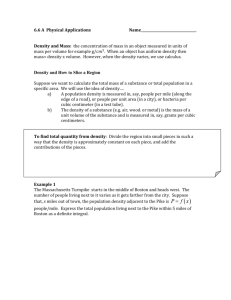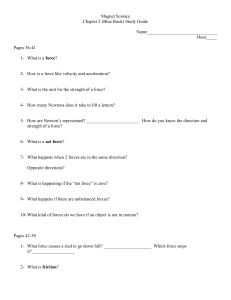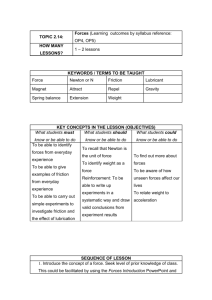13.11.04HPhysicsWeek13
advertisement
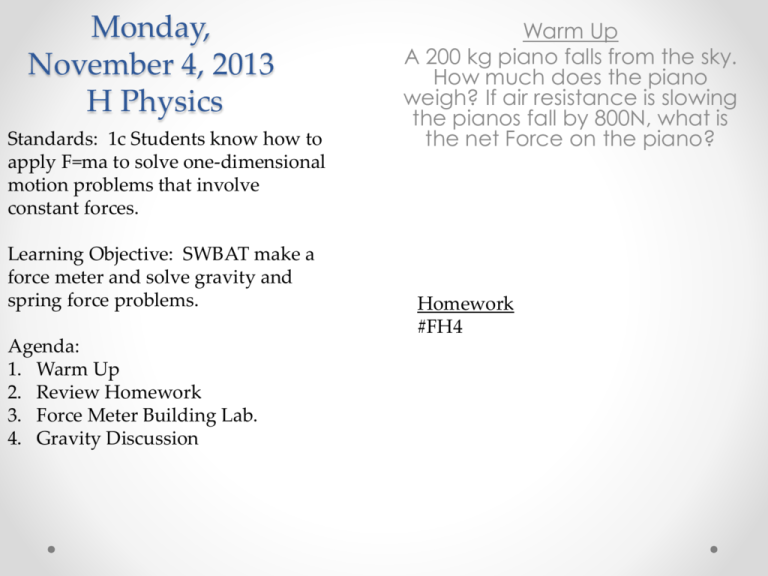
Monday, November 4, 2013 H Physics Standards: 1c Students know how to apply F=ma to solve one-dimensional motion problems that involve constant forces. Learning Objective: SWBAT make a force meter and solve gravity and spring force problems. Agenda: 1. Warm Up 2. Review Homework 3. Force Meter Building Lab. 4. Gravity Discussion Warm Up A 200 kg piano falls from the sky. How much does the piano weigh? If air resistance is slowing the pianos fall by 800N, what is the net Force on the piano? Homework #FH4 Tuesday, November 5, 2013 H Physics Standards: 1c Students know how to apply F=ma to solve one-dimensional motion problems that involve constant forces. Warm Up Find the net force of a1kg ball accelerating under a 55N Force, when friction is 16N and air resistance is 8N? What is the objects acceleration? Learning Objective: SWBAT understand how weight functions and build a a Force meter. Agenda: 1. Warm Up 2. Go over test. 3. Take survey 4. Finish Yesterday’s Lab Homework #FH4 Wednesday, November 6, 2013 H Physics Standards: Standards: 1c Students know how to apply F=ma to solve onedimensional motion problems that involve constant forces. Warm Up If a 1000kg car accelerates at 5 m/s2 even though 200 N of Friction is present, what would be the applied force of Car’s Engine? Learning Objective: SWBAT understand how weight functions and build a a Force meter. Agenda: 1. Warm Up 2. Discuss Mousetrap Car Lab 3. Tell Students their grades 4. Finish Force Meter Lab Homework #FH4 Thursday, November 7, 2013 H Physics Warm Up How much does 200g weigh? Standards: 1c Students know how to apply F=ma to solve one-dimensional motion problems that involve constant forces. Learning Objective: SWBAT finish building a force meter Agenda 1. Warm Up 2. Review Homework 3. Finish Force Meters Homework NA Friday , November 8, 2013 H Physics Standards: 1d Students now that when one object exerts a force on a second object, the second object always exerts a force of equal magnitude and in the opposite direction (N’s 3rd Law) WHST.9-12.2 Write informative/explanatory texts, including the narration of historical events, scientific procedures/ experiments, or technical processes. (HS-PS2-6) Learning Objective: SWBAT use Newton’s 3rd Law to predict and explain the readings on the Force Meters they created. Agenda: 1. Warm Up 2. Finish Force Meters 3. Begin Tug of War Warm Up a. If your Force Meter reads 9N when an object of unknown mass hangs from it, find the mass. b. How much force would you need to throw the object in order to make it accelerate at 4 m/s2? Homework #F5 Newton’s 3rd Law Force Meters • • • • • • • • • • • • • • • • Force Meters Objective: Students construct rubber band force-meters to aid in the investigation of forces and Newton’s 3rd Law. Engage Watch Video: Why do objects weigh less on the moon? What else might affect the weight of an object? Explore How can we use a rubber band to actually determine the weight (the force due to gravity) of an object? Explain In order to actually put numbers on our force meters, we have to know the formula for figuring put the amount of gravitational force Fg from a certain amount of mass m. The formula is Fg = mg (or W = mg) Elaborate How is this related to Newton’s 2nd Law, Fnet = ma?” Evaluate Students should now create an accurately labeled scale on their force-meters, displaying the applied force in units of Newtons. Problem Set: #F4 Fg = mg. Figure 5. Rubber band force-meter Symbols, units and equations Study Guide Equations: Constant Velocity v= Dx Dt d v = Dy = y f - yi s t Dx = x f - xi Constant Acceleration Dv a= Dt The Two equations of Motion 1. v f = vi + at 2. 1 Dx = vi t + at 2 2 Dy = y f - yi Dx = x f - xi The Two equations of Motion for Falling Objects ag=-9.8m/s2 v f = vi + agt 1 Dy = vi t + agt 2 2 --distance(d) and displacement (Δx or Δy ) units: meters (m) --speed (vs), velocity (v) units: meters per second or kilometers per hour (m/s, or km/hr) --acceleration (a) units: meters per second squared or kilometers per hour squared (m/s2, km/hr2) --time or change in time (t or Δt) units: seconds Forces Fnety = F1y + F2 y + F3y +...F Fnetx = F1x + F2 x + F3x +...Fnx Fnety = F1y + F2 y + F3y +...Fny Fnet = ma Fg = W = mg Types of Forces • From your book p. 94 Table 4-2 Force Symbol Definition Direction Friction Ff Resistive Force. Comes from rubbing against or sliding across surfaces. Parallel to the surface and opposite the direction of sliding Normal FN The force exerted on an object by the ground, a table, a platform, or any surface. Perpendicular to and away from the surface. Spring Fsp Restoring Force. The push or pull a spring exerts on an object. Opposite the displacements of the object at the end of the spring. Tension FT The pull exerted by a string, rope, or cable when attached to something. Away from the object and parallel to the string, rope, or cable at the pont of attachment. Thrust, Applied Force Fthrust,Fap A general term for the forces that move objects such as rockets, planes, cars and people. In the same direction as the acceleration of the object. Weight Fg Attractive Force of two objects due to gravity. Usually Earth and and object Straight down towards the center of the earth. Air Resistance/Drag FAR Resistive Force, comes from air/wind hitting moving objects Opposite of Motion #F2 nd 2 Newton’s Law Problems 1. If a student accelerates on his/her bicycle at 4m/s2, and the student has a mass of 77 kg. How much force does s/he apply to the bicycle? 2. Find the weight of the following people: Rickey is 100 kg, Manny is 150kg, and Donna is 65kg and the acceleration due to gravity is 9.8m/s2. 3 How much force does a baseball experience if the baseball bat accelerates the ball at 8m/s2 and the mass of the baseball is 5kg? 4. How much force would a 10kg baseball experience if the bat accelerated the ball at 20m/s2? 5. What is the mass of a bullet that accelerates at 100m/s2 by a 12 N Force when shot out of a gun? 6a. Thrust from a rocket’s engine equal to 100,000 N launches a shuttle with a mass of 10,000 kg into the air. What is the rockets acceleration? 6b*If the acceleration due to gravity is 9.8 m/s2 will the rocket be able to escape the earths atmosphere? 7. A wide receiver (90 kg) is tackled after catching a football by one of the safeties (99 kg). The safety applies a force of 250N? How fast did the receiver decelerate? (Be careful when you choose which mass to use.) Newton’s 1. 2. 3. nd 2 Law 2 #FH3 What does Fnet mean? What is the equation Newton’s 2nd Law. What do you change from Newton’s 2nd Law equation in order to find weight (W or Fg) ? 4. Find the net force of mini car racing if friction is 20N, the accelerator supplies 50N, and air resistance is slowing it down by 2N. 5. If the car from problem 4 has a mass of 1 kg, what is the car’s acceleration? 6. Which direction does Gravitational Force push? 7. Describe the Normal Force? 8. Friction acts in which direction? 9. If an object is flying northeast, which direction is air resistance pushing? 10. Find the mass of an object if it accelerates at 2 m/s2, when 20N of Force pushes it. 11. Find the mass of an object if it accelerates at 2 m/s2, when there is an applied force of 80 N, a force of friction of 20N, and air resistance of 10N. 12. Find the applied Force if a 20kg object is accelerated at 10m/s2 and friction is opposing the motion with 30N of Force. Weight & Spring Force: Problem Set #FH4 1. 2. 3. What is the weight of a 60kg person? Find the weight of a 300g object (in Newtons)? Find the weight of a 90kg person on the moon if gravity on the moon is 1/6 of earths 9.8 m/s2. 4. Find the mass of a plane whose weight is 4x105N? 5. A 4kg and a 6kg object fall from a plane. How much more Force will the 6kg object hit the ground with than the 4kg object? 6. The 4kg and 6kg object both fall from a plane 10,000 m above the ground. Which one will hit first? 7. A 10 kg object is on a planet of unknown gravity. If it takes 2s to fall 100 m from rest, how much does the object weigh? 8. A spring with a spring constant of 4N/m is stretched 0.2 m. How much force will the spring recoil with? 9. A spring pops up when released after being compressed with 40N of Force. If the spring constant is 100N/m how far was the spring compressed prior to popping up? 10. Find the spring constant of a spring if when compressed 1.5m it stores 2000 N of force? 11. What was the spring constant of the rubber band you used for a force meter if you made the 2 N mark when the rubber band was stretched 4cm? 12. An object of unknown mass is hanging from a spring with a spring constant of 2000 N/m. What is the object’s mass if gravity stretches the spring 0.1cm? (Hint: Use both Fsp=-kx and W=mg.) Student Learning Survey 1. Before taking the test, how confident did you feel about your understanding of Kinematics (motion)? 2. After taking the test, how confident did you feel? 3. Do you still try to succeed in this class? If not, what made you stop trying? 4. I learned Physics the best when Mr. Ancalade did……. 5. Do you do homework? If you do, does it help? If you don’t, why don’t you do homework? 6. If you did not turn in the cart and mass lab, why didn’t you? If you did not complete any portion of the lab, what was the reason? 7. I spend _____ minutes on Physics homework per night. 8. I spend ______ minutes studying for tests. 9. I spend ______ minutes studying for quizzes. 10. Is it helpful when Mr. Ancalade does problems on the board? If yes, explain how it helps. If no or not really, what are the reasons it doesn’t help or only helps a little? 11. When I don’t understand how to do something in the class, what do I do? If you don’t ask your peers or myself, what are your reasons? N’s 3rd Law: Tug-of-War To get a Full 10 pts. complete every section with questions. That does not include the explain section (which is lecture) or the Evaluate Section (I will grade this section separately) Write on a separate sheet. • Figures 6 (a) and (b): A student and a partner each pull on the opposing force-meters and observe that they show the same reading. In the second scenario, one student holds his force-meter still, while the partner pulls his force meter to the right. • • • Figures 7 (a) and (b): Students predict the reading on the force meter in each of the two scenarios depicted prior to testing. Engage What will happen to the motion of each chair when one of the students on the rolling chair pushes the other student on the chair. Will it matter which student pushes? Justify your answer. Tell me your reasoning. Explore Students attach their force-meters with rubber bands or string and record… • • o o • • • • • • • the reading on each force-meter when both students pull (Figure 6 a.) the reading on each force-meter when one student keeps his force-meter stationary while the other student pulls (Figure 6 b.) Explain Newton’s 3rd Law mini-lecture Elaborate Recreate the Figures 7(a) and (b). Write predictions for the force-meter readings for each of the two scenarios in Figure 7 . Next, test your predictions, discuss your results in a group and be ready to participate in a discussion about these results. Evaluate Newton’s 3rd Law Assignment: #F5 Due Monday Newton’s rd 3 Law Notes 1. Using your Engage Experience, define Newton’s 3rd Law - 3 minutes. 2. Discussion - 2 minutes Newton’s 3rd Law: Definition: For every action (Force) there is an equal and opposite reaction (opposing Force) Equation FBA = -FAB B FBA A FAB Where FBA is the Force of B on A and FAB is the Force of A on B Example 1.An object on a table is pushing down on the table because of gravity and the table is pushing up on it with normal force. 2. The Force of gravity occurs when there are 2 masses, each of them pulling on each other with an equal and opposite force. 3. Friction and a Car’s tires. Non-Example Trying to move from one point to another in space by waving your arms and legs furiously. Notes 5 mins #F5

